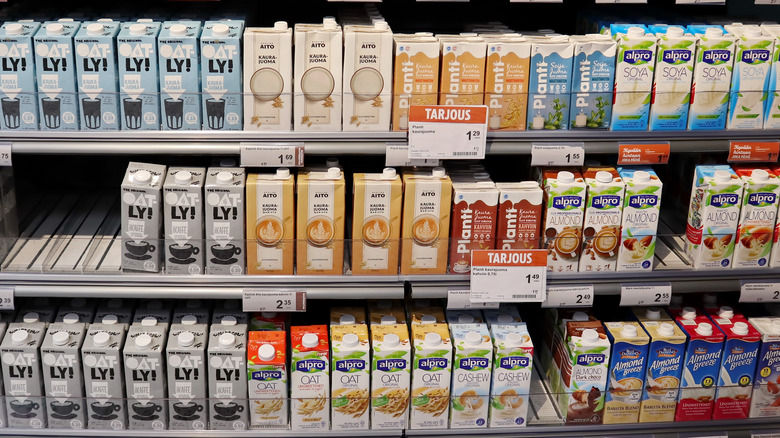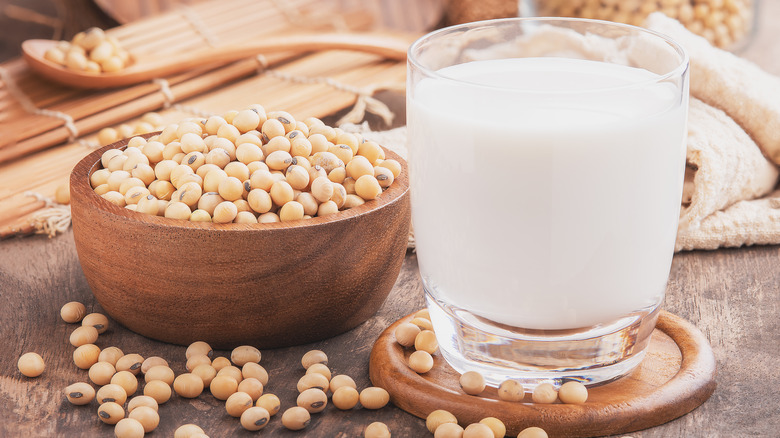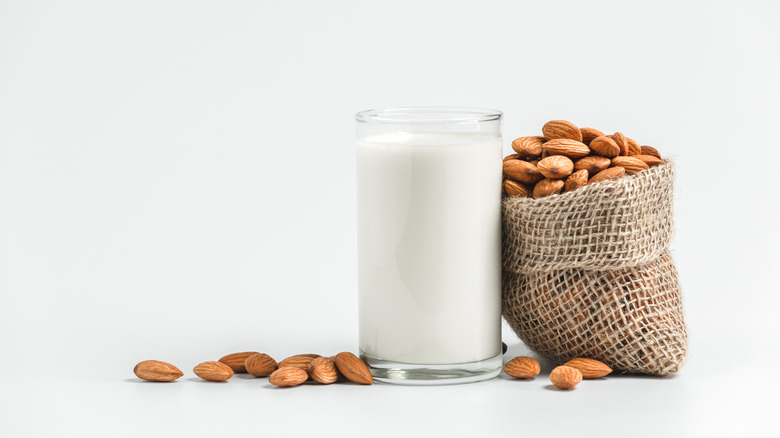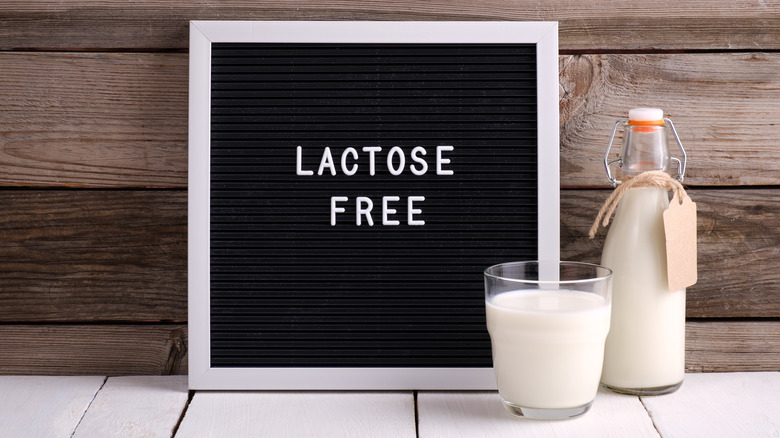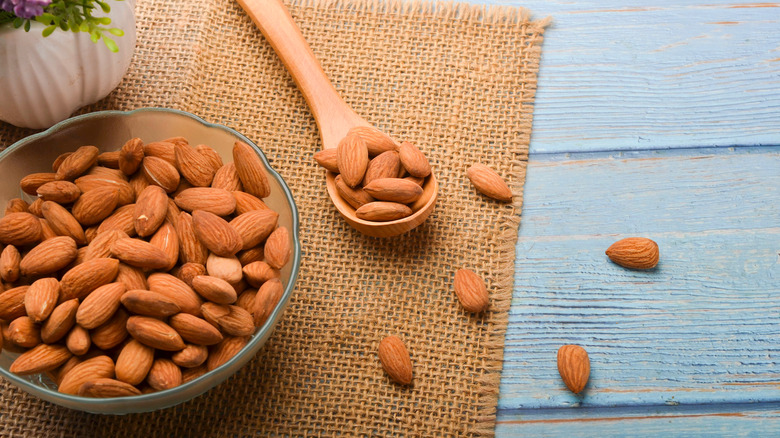Soy Milk Vs Almond Milk: What's The Difference?
It seems that with every grocery store visit, new plant-based products are being stocked to cater to a wider range of diets and lifestyles. Among the various items, non-dairy milks (commonly referred to as mylks, due to their absence of lactose), have seen huge increases in market values. Better Marketing estimates that the industry will be valued at $21.52 billion by the year 2024, growing at a steady 10% rate every year.
Of all the types available, almond and soy milk are two of the more frequently seen dairy alternatives. Yet for the average consumer, it might be hard to decide which is better for you — or tastes better.
Both options have their pros and cons, including nutrition levels that need to be evaluated on an individual basis. For example, an infant will have different dietary needs than a grown adult, so it is important to look at the overall context before choosing which to buy. The primary distinction is that soy and almond milks are made from a different base, soybeans and almonds respectively. The rest of their content is largely made up of water, a variety of stabilizers, and fortified additives, according to the Mayo Clinic.
On the whole, almond milk is a lower calorie and lower fat choice, however it is largely lacking in protein, unlike soy milk. The latter is far more similar to cow's milk and is the closest approximation to a substitute, nutritionally speaking.
What is soy milk?
For a long time, soy milk was mostly known solely as the byproduct of a step in tofu production, according to Soy Info Center who further reports that soy milk was largely concentrated in Asia until the 20th century. Its consumption wasn't a linear trend in the US, and took time to develop, partly due to the bean-like flavor and sometimes associated digestive issues.
Serious Eats indicates that soy milk was a common substitute for dairy during times of war rationing. The source describes many versions of soy milk that were on the market, including bottling it like soft drinks for extra appeal. Once the flavor and digestive side effects were adjusted, the article says there was a rise in popularity in the 1980s.
Go Dairy Free highlights that there have been many inconsistencies regarding the health consequences of soy (a good number related to its influences on the production of estrogen), which caused a dip in the booming industry at points over time. Over the past decade, however, further research has eliminated some of those fears. While soy milk lags behind the almond milk industry with annual sales around $230 million, according to Statista, it still remains a popular option among those looking for dairy-free alternatives.
Healthy Food Guide reports that whole soybeans or soy protein can be used to make soy milk. The source describes the process, noting that first the beans are soaked in water, and then blended with water. Next, the mixture is heated to remove the unpleasant bean flavor, before being filtered. Stabilizers, emulsifiers, and some fortified additives are introduced before sterilization and packaging.
What is almond milk?
Like soy milk, almond milk is made by soaking the nuts in water, then blending them with water, and straining out the pulp. Sweeteners or flavoring may be added, though unsweetened plain options are often produced. Also, many manufacturers fortify their almond milk with numerous vitamins and minerals to improve the nutritional density, says The World's Healthiest Foods. Aside from flavoring agents and extra nutrients, emulsifiers are usually added for stability as well, increasing the ingredient list on most commercially produced kinds.
Due to these production methods, Live Science notes that the milk only really contains around 2% almonds. The result is a mildly nutty beverage with a milky texture, and there's also vanilla and chocolate flavors for a little bit of enhancement in the flavor profile. If you want more almonds in your milk and consequently more nutty flavor, making it yourself is a better option than store-bought.
Although almond milk may seem like a new phenomenon, history professor Ken Albala tells Smithsonian Magazine that aristocrats in Medieval Europe were particularly fond of it even in that era. While almonds originated in the Middle East, they made their way to Europe around the 8th century and were soon popular as milk in numerous recipes. In fact, it became a staple among European Christians who obeyed dietary rules that restricted animal consumption, the magazine reports. Eventually, as the church became more lenient regarding food choices, almond milk faded into the background. Nowadays, with veganism and dairy-free alternatives on the rise, the almond milk industry currently tops $1 billion (via Statista).
What are the nutritional advantages of each milk?
Both almond and soy milk are lactose- and dairy-free, which is ideal for people with intolerances or anyone following a vegan diet. In terms of practicality, both options come in shelf-stable formats, requiring refrigeration only after opening.
Almond milk in a plain unsweetened format is a low-calorie option, averaging 40 calories in one cup, says Healthline. The low calorie count as well as the minimal sugar content in unsweetened versions makes it suitable for those managing weight and/or sugar intake.
As far as fat content, Well Seek indicates that both almond and soy milks are low in saturated fat, which is associated with lower levels of LDL cholesterol and heart health. The majority of the vitamin and mineral content in both options is a result of fortification. Every brand will have their own ratio so consumers can choose based on their nutritional needs. Most have high levels of calcium and vitamin D to mimic cow's milk, though this won't be the case in homemade varieties.
Soy milk is not especially low-calorie, but it does make up for it with more protein, ranging from 6-10 grams per cup, says Verywell Fit. Soy is also a complete protein, containing all nine essential amino acids, according to Livestrong. In a 2018 study in the Journal of Food Science and Technology, soy was deemed most similar to cow's milk in terms of fat, carbohydrate, and dairy balance, if you're looking for the most comparable swap.
What are the health disadvantages of each milk?
Although those with lactose allergies are supported by these two dairy-free alternatives, soy and almonds on their own are also common food allergens and should be avoided by those affected. While plenty of controversy surrounds soy, The American Cancer Society indicates that most of the negative results are related to high concentrations of isoflavones, seen mostly in supplements. And, although fortified soy and almond milk products contain impressive percentages of vitamins and minerals, it's good to know that the absorption rates are not always clear. GrowFit reports that soy contains high levels of phytates which can interfere with mineral absorption, reducing the nutritional value of the drink. As for almond milk, Happy Body Formula notes that the majority of the phytic acid from phytates is eliminated during the soaking process.
Although almonds are a high-protein and fiber-rich food, Healthline indicates that very little of the nutrients find their way into the milk. Therefore, the source states that it is not suitable for infants as a replacement to dairy or formula. Likewise, while low-calorie options might be ideal for someone managing their weight, but they are not appropriate for young children in peak stages of growth. As for sweetened and flavored versions, they significantly contribute to sugar content and should be consumed sparingly; these alternatives in particular are not as nutrient dense, nor as natural compared to cow's milk.
Due to large demand for soy products, GrowFit reports that GMO crops have increased, and high quantities of pesticides and herbicides are frequently used so choosing organic options is always a good idea, too.
How can you use both soy and almond milks?
Both almond and soy milk can be used much like cow's milk, however the flavor profile may vary. As mentioned, both types come in an array of flavors and may be sweetened or not. Depending on your use, you may choose to opt for one of these enhanced versions, such as if you are making a milkshake.
Plain, unsweetened almond milk tends to have more of a neutral flavor and can be incorporated in both sweet and savory dishes. Blue Diamond recommends using it for soups, sauces, and pasta dishes, simply substituting the dairy content in a 1:1 ratio. Food & Wine confirms the flexibility of almond milk in recipes by suggesting to use it in mashed potatoes, creamed spinach, French toast, curry, and ice cream.
Depending on your taste, you can enjoy either soy or almond milk as a plain drink, splashed in your coffee as a creamer, or poured in a bowl of cereal. As well, both milks can be used in smoothies, though soy milk will add more nutritional benefits if you plan to drink it as a meal replacement. The two can also be used in place of cow's milk when baking.
What are the environmental impacts of each milk alternative?
A lot of controversy surrounds the environmental impacts of dairy alternatives, however according to the BBC, carbon emissions and land and water usage are all better with plant-based milks, compared to the production of cow's milk. Almonds have the highest water use; Reader's Digest notes that 80% of these nuts are grown in California, which regularly faces drought. The source remarks that high production entails more toxic chemical use, which in turn negatively affects the ecological harmony. Almonds also require bees for pollination, and Reader's Digest explains that the almond season is not synchronized with pollination behavior, ultimately pushing the bee cycle out of balance.
Soy, on the other hand, requires less water than almonds, and BBC points out that it doesn't necessarily entail wreaking havoc on the environment. The source indicates that the majority of soy for consumption is grown in Europe or China, and doesn't lead to deforestation like many activists have claimed.
Dairy alternatives are often consumed by health-conscious people who may also wish for organic products. However, BBC indicates that organic farming requires greater land area and, in turn, increases carbon emissions, which may negate the other benefits.
A general rule if you're opting for better dairy alternatives, seek out environmentally conscious manufacturers who share their farming and production methods in order to be informed and make the right decisions.
